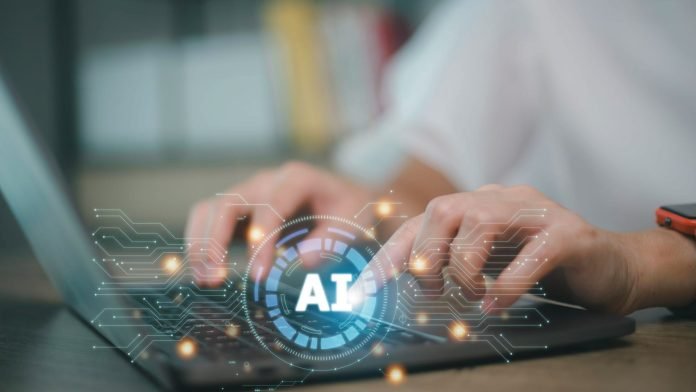It seems impossible to escape AI.
After countless company meetings and reading endless blogs, we know to an extent what to expect and the potential use cases for certain AI technologies. But how is AI actually changing the learning and development (L&D) landscape as we know it?
Today, L&D leaders are under pressure to do more with less and win back time to focus on strategic goals. While, at the same time, raising the bar on engaging, interactive learning experiences.
AI-powered tools offer the promise of increased speed and efficiency. However, rapid technological advancement creates skill gaps within the organization, making it challenging to fully leverage these new capabilities and achieve business results. Like any new tool, you need to know how to use AI to get the most from it. Organizations also need to overcome the significant hurdles to AI adoption, including legal, security, and data privacy concerns.
That being said, transformational business results are being achieved across a diverse range of applications. And we’re starting to see how the long-term impact of AI on learning management and the learning experience itself will be profound. We just have to lean into our curiosity to become proficient in using AI and understand what AI means strategically for L&D and our wider organization.
Artificial Intelligence: A Current Overview
The biggest impact of the AI revolution is its ability to accelerate tasks. From writing code to crafting emails, AI can do the bulk of the work, allowing us to do more and faster.
With generative AI, it’s changed the way we interact with technology and data in a profound and lasting way. It allows us to ask for what we want in natural language versus learning the syntax of the system.
The ease of use of chat interfaces has removed the learning curve for adopting and interacting with technology. It has democratized access to powerful tools that were previously the domain of the computer programmer or advanced system operator. Today, we’re in the chat interface phase. However, we’ll quickly advance into voice and other more natural, human-focused interfaces to the same powerful ecosystem.
Users can ask the AI questions, but more importantly, users can get business insights, take actions, and complete tasks using the same AI tools. For example, the request “assign my team the latest compliance training” is a simple instruction. However, AI has to understand who you are, who your team is, and what compliance training you’re referring to. AI can infer this context automatically by connecting many disparate data sources and systems behind a ubiquitous chat interface.
The speed of AI also reduces the time it takes to make decisions. With data and analysis right at your fingertips, business leaders can make informed decisions and even consider predictive analysis when making complex decisions.
When used by L&D teams, AI can also help generate, customize, and personalize the learning experience, supporting learning leaders in achieving better results with less effort.
AI’s Impact on L&D
According to the Association of Talent Development (ATD), the top outcome of using AI in L&D is increased time or speed at which learning can be deployed. Leaders are looking for learners to learn faster and put that knowledge into practice. In ATD’s research, L&D companies plan on primarily using AI-powered applications for technical and product training, leadership development, and employee onboarding.
With AI-powered technology, there’s also been a shift in focus from knowledge to skills-based learning. By incorporating advanced generative AI tools, a learning management system (LMS) can easily generate comprehensive summaries, exams, scripts, engaging images and videos, translate text, and develop complete courses within seconds rather than weeks to rapidly develop skills. This accelerated efficiency can produce increased worker productivity and revenue.
What’s more, AI enables these platforms to personalize learning at scale. Each learner is different and unique in how they learn. As companies scale, it’s important to create unique journeys based on their interests and needs. AI and automation can send perfectly timed prompts or pace learning that helps them focus on goals.
Additionally, AI can deepen the learning experience itself. For example, scenario-based learning involves the learner playing one role and the AI playing the other.
AI Considerations
While AI content tools can produce visuals, identify relevant assets for new courses, or curate specific content for learners, there are always concerns about accuracy and control.
It’s important that humans interacting with AI are properly enabled to understand how to use the tools and interpret the responses. Additionally, it is critical that the AI-powered tools themselves provide safeguards against inaccurate responses built-in.
Content can be a huge burden and incredibly time-consuming for L&D teams to create and manage. To have engaging, interactive content and learning experiences, authoring tools need to create high-quality assets that feel personal and localized to users. With outdated legacy content and new skills being introduced every day, L&D teams have the herculean task of supplying a substantial and timely volume of work that meets learners and the world where they are today.
With AI, teams can accelerate the creation process by drafting learning courses or assets from existing knowledge bases that are in line with a company’s learning objectives, policies, and procedures. Humans can then edit and refine the materials, depending on the organization’s messaging, desired outcomes, or target audience.
One of the other major hurdles L&D teams face is providing unique learning journeys at scale. It’s one thing to individualize and cater to 100 employees’ unique learning styles, but what about 1,500? Or 50,000? AI and automation can dive into data-driven assessments, use those insights to adapt to individual strengths or weaknesses, and adjust the learning pace or content for learners. Certain LMS providers offer AI reflection coaches to engage with learners and reflect on their learning with interactive guides. This helps individualize courses and learnings, reinforcing personalization and keeping learners on track wherever they’re on their learning journey.
Finding the Perfect Fit for AI
No question, AI is here to stay and is revolutionizing how information and learning are managed and delivered. Furthermore, AI is fundamentally changing the way we interact with data and systems in a very positive way. AI does not replace the need for L&D, but when used skillfully, it can enhance our abilities to complete tasks faster and to a higher quality than previously possible.
Although there are challenges to overcome in the adoption of AI, rewards are available for those who can navigate those challenges successfully.
Responsible use of AI in learning is an emerging trend, and you should expect to see more of this as customer-focused learning platform providers start to address the adoption barriers of their customers. By harnessing AI-powered tools, L&D leaders can achieve their goals while improving the experience for their learners.
Explore HRtech News for the latest Tech Trends in Human Resources Technology.
ABOUT THE AUTHOR

Steve McCurry
VP of Product at LearnUpon
Steve McCurry, VP of Product at LearnUpon, is a customer focused, data-driven product manager with experience building and leading cross-functional teams including product, growth marketing, design, user research and data and analytics.
Before LearnUpon, he held roles including senior manager of product management at Amazon Web Services for five years, senior director of product and growth at Carbon Health, and director of product management at Udemy, aiding in the company’s expansion and fundraising. Steven has a degree in Computer Science from the University of Sheffield.












